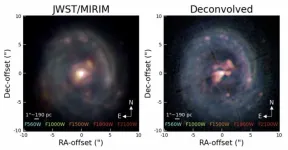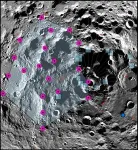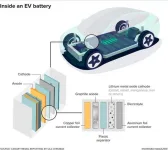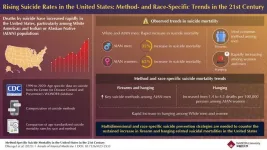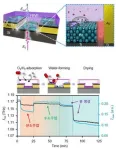(Press-News.org) (SAN ANTONIO, TEXAS) — Mason Leist is working remotely—127 million light-years from Earth—on images of a supermassive black hole in his office at the UTSA Department of Physics and Astronomy.
The UTSA Graduate Research Assistant led a study, published in The Astronomical Journal, on the best method to improve images obtained by the James Webb Science Telescope (JWST) using a mathematical approach called deconvolution. He was tasked by the Galactic Activity, Torus, and Outflow Survey (GATOS), an international team of scientists, to enhance JWST observations of the galaxy NGC 5728.
The GATOS team, co-led by UTSA Professor and Leist’s doctoral advisor Chris Packham, was awarded time on the JWST for its research on black holes.
“It’s incredibly humbling,” Leist said. “Not just working with JWST data, which is a great opportunity and a crazy amount of science, but working with our collaborators. It’s a very incredible experience to collaborate with other members of the GATOS on this. I like to tell people that this work represents the efforts of 35 individuals from institutes in 14 countries.”
Leist deconvolved simulated and observed images of an active galactic nucleus (AGN), a region at the center of the galaxy NGC 5728. The central engine of an active galactic nucleus, comprised of a hot and turbulent accretion disk orbiting a central supermassive black hole enshrouded by a thick torus of gas and dust, plays a key role in feedback between the AGN, host galaxy and intergalactic medium.
He tested five deconvolution algorithms over two years on simulated observations of an AGN. Of the five methods tested, the Kraken algorithm improved the simulated AGN model image quality the most and was therefore applied to JWST observations of NGC 5728. Kraken is a high-performance multi-frame deconvolution algorithm developed by a team of researchers led by Douglas Hope and Stuart Jefferies at Georgia State University.
JWST observed NGC 5728 at five distinct wavelengths. In these observations, a faint extended feature was seen in only one wavelength. As Leist deconvolved the data, the faint extended emission feature was revealed in all wavelengths, demonstrating the effectiveness of Kraken deconvolution to improve JWST image quality and enhance faint extended emission features.
“We believe the extension could be part of an outflow from a supermassive black hole that could be interacting with the host galaxy. There’s a lot more science that needs to be done,” Leist said. “It is difficult to distinguish the extended structure in all of the JWST images, but by using deconvolution techniques, we reduced the image data to reveal the hidden faint emission feature.”
The process was also a collaboration with Willie Schaefer, UTSA’s Adobe Creative Cloud support specialist, who helped create a scientifically accurate set of color images for the study.
Leist’s work demonstrates deconvolution is an efficient and accurate tool for image processing. Similar methods, he and Packham said, can be applied to broader science cases using JWST observations. The approach has garnered significant interest from fellow scientists working on JWST image processing.
“We’re doing important work using JWST data,” Packham said. “But it’s important because we can improve on the raw data and get better image quality to see those fainter details by using this approach. It shows the strength of collaboration within the GATOS, which is co-led from UTSA.”
Leist’s work to enhance the JWST observations of the galaxy NGC 5728 is a new piece in the puzzle that further demystifies the origins of the universe. The full scope of the deconvolved images and other astrophysical results will be described in forthcoming studies currently underway by the GATOS.
“It goes back to the generation of galaxies shortly after the Big Bang,” Packham explained. “If we really want to understand our place within our own galaxy, within our own solar system and within the universe in general, we have to understand what’s going on within black holes in our galaxy and, indeed, other galaxies. We can understand the formation of our galaxy, our solar system, the earth and life on earth. It’s really part of that big picture question.”
Explore Further
Discover the UTSA Department of Physics and Astronomy and the UTSA College of Sciences.
Read about previous JWST work at UTSA.
END
UTSA researchers reveal faint features in galaxy NGC 5728 though JWST image techniques
2024-01-25
ELSE PRESS RELEASES FROM THIS DATE:
Polymer power: Incheon National University researchers enhance the safety of lithium batteries
2024-01-25
Lithium-ion batteries are a widely used class of rechargeable batteries in today’s world. One of the processes that can hamper the functioning of these batteries is an internal short circuit caused by direct contact between the cathode and anode (the conductors that complete the circuit within a battery). To avoid this, separators composed of polyolefins—a type of polymer— can be employed to maintain separation. However, these separators can melt at higher temperatures, and the inadequate absorption of electrolytes (essential for conveying ...
Suicide and race: Uncovering patterns underlying increasing suicide rates in the USA
2024-01-25
Are there specific communities that bear the brunt of suicide mortality? Certain studies have revealed that historically marginalized and economically deprived indigenous populations are linked with higher rates of cluster suicides—especially in Canada, the United States, and Australia. Public health officials need to consider that the risk of suicide contagion—social transmission due to insufficient interventions and resources—is real and must be countered. Now, a consortium of public health experts from Japan, Australia, and China have analyzed trends in suicide mortality in American Indian or Alaskan Native (AIAN) populations, while exploring ...
Deep learning reveals molecular secrets of explosive perchlorate salts
2024-01-25
Perchlorates are a class of compounds that are notorious for their explosive nature. This raises safety concerns during experiments involving complex compounds that contain perchlorate ions, since explosions can be triggered even by the slightest shock or heat. It is, therefore, important to study their molecular structure and understand the reason behind their explosive nature.
In this context, a method called the Hirschfield surface analysis has been extensively used for visualizing and quantifying the crystal structure and molecular interactions of crystal compounds. Moreover, a two-dimensional fingerprint plot derived from the Hirschfield ...
National retailers support heart and stroke health through annual Life is Why™ campaign
2024-01-25
DALLAS, Jan. 25, 2024 — This February, during American Heart Month and the American Heart Association’s Centennial year, the Association is devoted to a world of healthier lives for all by teaming up with retailers and brands around the country for Life is Why™, a cause marketing campaign supporting the Association’s life-saving heart and brain health mission. Life is Why inspires consumers to celebrate their reasons to live healthier, longer lives and participate personally in the mission of the Association by donating at the point-of-sale or by purchasing a product ...
Permeable pavements could reduce coho-killing tire pollutants
2024-01-25
PUYALLUP, Wash. — The pore-like structure of permeable pavements may help protect coho salmon by preventing tire wear particles and related contaminants from entering stormwater runoff, according to a Washington State University study.
Researchers demonstrated that four types of permeable pavements can act as giant filters, retaining more than 96% of applied tire particle mass. They also captured several tire-associated chemicals, resulting in a 68% average reduction of 6PPD-quinone, a contaminant shown to kill coho salmon in urban streams. The study findings were published in the journal Science of the Total Environment.
“The pressure on existing stormwater management technologies ...
Study: UAB researchers establish optimal immunosuppression regimen for pig-to-human kidney transplants
2024-01-25
Read all news releases on UAB’s peer-reviewed, published xenotransplant research and find media kits with video, photos, graphics and more at go.uab.edu/xenotransplant
The UAB News Studio is available for live or taped interviews with UAB experts.
BIRMINGHAM, Ala. – Currently used Food and Drug Administration-approved transplant drugs — with the addition of an also already FDA-approved complement inhibitor — are the optimal immunosuppression regimen for pig-to-human kidney transplants, according to a landmark discovery by University of Alabama at Birmingham investigators. The peer-reviewed research is published today in the Journal of Clinical Investigation.
“These ...
Potassium-enriched salt is the missing ingredient in hypertension guidelines
2024-01-25
A call to include recommendations on low-sodium potassium-enriched salt in hypertension treatment guidelines has been made by an international group of experts today in the American Heart Association’s scientific journal Hypertension.
High levels of sodium intake and low levels of potassium intake are widespread, and both are linked to high blood pressure (hypertension) and greater risk of stroke, heart disease and premature death. Using a salt substitute where part of the sodium chloride is replaced with potassium chloride ...
Researchers establish brain pathway linking motivation, addiction and disease
2024-01-25
New findings published in the journal Nature Neuroscience have shed light on a mysterious pathway between the reward center of the brain that is key to how we form habits, known as the basal ganglia, and another anatomically distinct region where nearly three-quarters of the brain’s neurons reside and assist in motor learning, known as the cerebellum.
Researchers say the connection between the two regions potentially changes our fundamental view of how the brain processes voluntary ...
How COVID changed the way Americans work, and how much money they have
2024-01-25
According to a new paper in the Review of Economic Studies, published by Oxford University Press, the widespread adoption of work-from-home technology has had dramatic consequences for American life. Using an equilibrium model where people choose where to live and how to allocate their time between working at home and at the office, the researchers here find that the pandemic induced a substantial increase in the relative productivity of those working from home. This change has increased housing prices, reduced office rent costs, and will permanently ...
Development of real-time trace hydrogen gas leakage via a novel terahertz-wave optical platform
2024-01-25
Hydrogen gas is the smallest and lightest of all known molecules, and its colorless and odorless nature makes it easy to leak. Also when concentrated above 4% in a confined space, it poses a risk of ignition or explosion. In order for hydrogen to become a major player in the future energy industry, it is essential to ensure the safety issues via ultra-sensitive gas detection technology over the entire gas-dealing processes such as gas production, storage, and transportation. However, conventional gas-leakage sensors using electric signals are prone to yield electrical sparks, which can cause an explosion of leaked hydrogen gas. In addition, the mainstream electrode-based contact sensors ...
